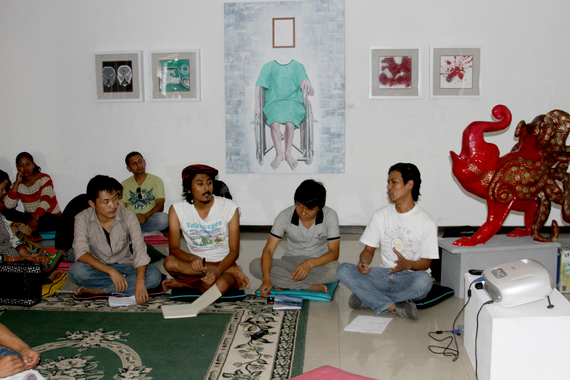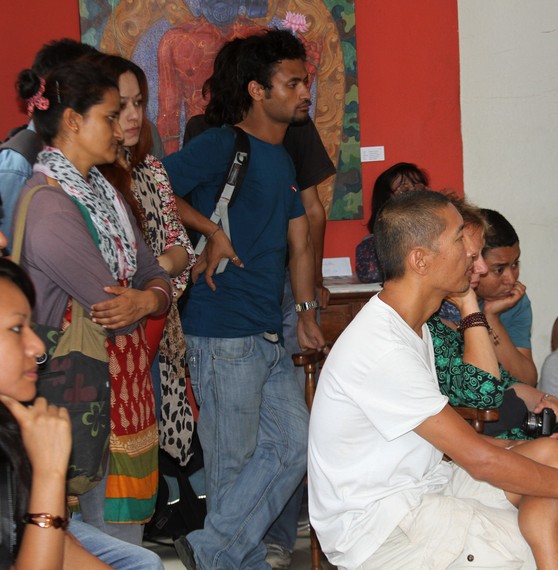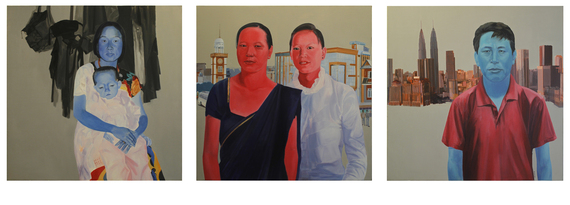"What is the role of art? What is it for?" reflected Arjun Khaling while responding to moderator Hitman Gurung on Sunday at Kathmandu's Siddhartha Art Gallery. The ongoing exhibition, Amalgam, features paintings and prints by twenty-six contemporary Nepali artists; Sunday's program was one of four weekly discussion sessions being held at the gallery this July.
Gurung kicked off the event with a brief slideshow presentation featuring examples of art that represents artists and various socio-political movements in the world -- Dadaism, American Civil Rights, and China's Al Wei Wei, to name a few.
Khaling succinctly provided a historical context to the panel discussion: "Since Nepal was mostly sheltered from the rest of the world until 1950, artists weren't exposed to new ideas. But after the fall of the Ranas, they became freer and more independent. Even then, there is nothing noteworthy in terms of arts movement in the fifties. When King Mahendra declared Panchayat in 1960, artist Lain Singh Bangdel returned to Kathmandu after studying in several Western cities, mostly Paris. His style was innovative but he isn't known for his arts activism."
There were sporadic attempts of creative expression now and then in the decades that followed, explained Khaling, but it was only during the political movement of 1989 that one starts to notice an intersection between arts and politics. Pamphlets, posters and fliers were seen on the streets but those are mere examples of straight out political propaganda. "When, in 1995, the Communist Party of Nepal (Maoists) started to revolutionize, taking the issues of marginalized groups such as Dalits and Janajatis, Nepali artists finally saw their role in society and politics clearly." By 2005/2006, artists like Ashmina Ranjit were making art that placed peoples' issues at its center. Ranjit is known for exploring feminism in her work; others were dabbling with topics such as identity, culture, class and government.
Once Nepal became a republic in 2008, artists also came together and declared an 'arts revolution' in Nepal. As the Department Chief of Fine Art at the Federal Socialist Party in Nepal, Khaling is actively following the constitution making process. He also helped found Kirant Lalitkala Samaj (Kiranti Aesthetics) because he wants to reexamine his culture and its historical roots. "Some artists say that art should be for art's sake," said Khaling, "but I am pushing a political agenda through my art."
Gurung, who recently co-founded Artree Nepal along with his contemporary Sheelasha Rajbhandari, turned to another panelist, Sanjeev Maharjan, a visual artist, and asked a similar question: What are your thoughts on artistic practices? Does art have a role in influencing society?
Maharjan: I want to first answer that question as a student because it largely comes down to our education system. Art is still taught mainly in terms of aesthetics. I believe that education should emphasize art's role in critical thinking, imagination and developing ideas. Skills and techniques are important but all these should be taught simultaneously.
When asked to comment on his involvement with arts movement, Maharjan said, "Art should compel people to question. It definitely plays a major role in society and politics. I participated in the Social Arts Practice workshop in Bangladesh recently which focused on 'Arts as Action' and 'Arts as a Creative Medium'. Our target group was a slum near Chittagong. Artist Sunita Dangol and I focused on Women's Health. We demonstrated creative ways to turn cloth into sanitary pads because we wanted to raise awareness amongst women regarding menstruation."
To the third panelist, Mekha Limbu, Gurung asked: We have noticed socio-political themes in your work, some very personal. What were your influences? These days it's almost become fashionable among young students to get involved in similar work.
Limbu: It perhaps goes back to college days. Viewing political art influenced me subconsciously, I think. I have been involved in several projects since then. I also worked with Ashmina Ma'am. As an artist, ideas gradually developed inside me. I was also learning about World History and the role art has placed in civil movements. Is someone really an artist if s/he is not socially responsible? There are several global movements these days; it's easy to get informed and influenced. How do artists respond to that? For example, regarding migrant workers, I produced a piece of art about my father who has been working in Qatar for many years. I think it's extremely enriching to infuse your art with socio-political issues. The process itself is rewarding; it involves research and learning new things.
Gurung returned to an earlier theme with Khaling: You mentioned the year 1950 and the gradual awakening of Nepali artists. This reminds me of similar periods in European history. In some cases, there were Communist agendas in art. We also have artists who are aligned to certain political parties but then there are some who work independently. What do you have to say about this dichotomy?
Khaling: There are several examples of the interplay between art and politics: issue-based, independent or directly opposing certain political ideas. In some cases, politics is primary, art secondary and in others, there is a nice balance between art and politics in order to raise overall awareness. I believe that the quality of art should be kept in mind along with the issue, concept, the artist's background, etc.
Gurung: Could you elaborate some more on the connections between personal, social and political when it comes to art?
Limbu: The context is very important for artists. We noticed remarkable examples of alternative art during the post-conflict period. I think the situation influences and compels artists.
Khaling: I think artists started asking important questions regarding socio-cultural norms during Nepal's recent political transition. Why are certain practices there? Why are certain things done? For example, our party's agenda is decentralization. I believe that we should have regional universities, academies and facilities that match those in Kathmandu. My art reflects that belief. We are also working to improve and develop National Academy of Fine Arts (NAFA) because that will be beneficial to the entire nation."
Gurung: What are some problems and challenges facing socio-political arts practice in Nepal?
Maharjan: I wonder whether that theme is coming up only as a subject. Has there been any real work or tangible solutions? Is it merely done for grant money? Who are we working for? Where are we showing our work? For example, if we do an arts project in the slums, are the issues actually getting solved? I have learned that we can't work individually. We need to collaborate with local people and involve them.
Gurung: How challenging is that? For instance, journalists have access to certain venues and events. The state provides them passes. Artists don't have that kind of systemic support.
Limbu: I have been asking those questions myself. If we have an idea, who do we go to? Who is the right person? Maybe NAFA? It takes time to research these things; budgetary considerations need to be made. But ultimately, artists also have to do the work."
The program was conducted entirely in Nepali. This article is based on my notes and translations.



